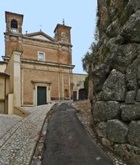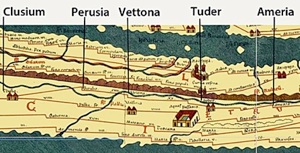


Pre-Roman Period
According to Pliny the Elder, Cato the Censor dated the foundation of Ameria (Amelia) to precisely 964 years before the Romans war with Perseus, King of Macedon, which ended in the Roman victory at the Battle of Pydna (168 BC). This implied that Amelia had been founded in 1132 BC, some four hundred years before the foundation of Rome. Festus added another snippet; that Ameria had been named for its founder, King Amiro.
Whatever the precise truth of this, excavations in 1993 under the Collegio Boccarini (the home of the newly re-organised Museo Comunale, Amelia) revealed signs of habitation from the 9th century BC. This settlement seems to have been one of a number of hill forts in the surrounding region that offered temporary protection to a diffused rural community.
Traces of two cult sites that were probably associated with this diffused population survive:
-
✴A necropolis and associated sanctuary that were in use from the the 6th until the 2nd century BC were excavated at the end of the 19th century at Pantanelli (southeast of Amelia). Some finds from this site are displayed in the Museo Comunale, Amelia. The type of tombs and the prestige grave goods found at Pantanelli suggest that the existence of a ruling élite from the 6th century BC. A terracotta antefix found nearby suggests that the sanctuary was monumentalised at some time in the 4th century BC.
-
✴A cave known as Grotta Bella that had been inhabited in Neolithic times was discovered in 1902 to the northwest of Amelia. Some 300 simple lead and bronze votive offerings that were found inside (some of which are in the Museo Archeologico Nazionale, Perugia) suggest that this was also a cult site from the 6th until the 2nd century BC.
The central part of a double-sided Umbrian inscription on bronze (late 4th century BC) was discovered in the 19th century outside Amelia. This inscription seems to record a dedication to a deity, perhaps Jove. The find-spot is thought to have been a cult site near Sambucetole, some 6 km north of Amelia that was monumentalised in ca. 200 BC. The remains of this later temple survive in a farmhouse known as the Podere di Santa Maria in Canale.

A necropolis was discovered just outside Amelia in 1963, when the Consorzio Agrario (agricultural co-operative) on Via Rimembranze was demolished. Most of the tombs had been violated, but the remaining grave goods, many of which are of high quality, showed it to have been in use over a long period, from the 7th century BC until perhaps the 2nd century AD. This necropolis was formalised in the 4th century BC, after which the simple graves were laid out on shallow steps.
Roman Ameria
Paul Fontaine (referenced below, at p. 79) suggested that the surviving stretches of Roman wall that flank the medieval Porta Romana might date to the 3rd century BC: Via Amerina would have entered the city at this point. However, the city that the Romans called Ameria does not appear in our surviving sources until 80 BC, when Cicero defended of of its citizens, Sextus Roscius (see below): it is clear that, by this time, it was a thriving municipium. Pliny the Elder (‘Natural History’, 3:19), included the Amerini in his list of the peoples of Umbria who were assigned to the Augustan Sixth Region.
Via Amerina

Tabula Peutingeriana (from the website by the Biblioteca Augustana der Fachhochschule, Augsburg)
Rome to Ameria

Tabula Peutingeriana (from the website by the Biblioteca Augustana der Fachhochschule, Augsburg)
Ameria to Clusium
An inscription (CIL IX 5833, ca. 130 AD) from Auximum (modern Osimo in the Marches) commemorates its patron, the splendidly named Oppius Sabinus Iulius Nepos Manius Vibius Sollemnis Severus, whose career had included the post of curatori viarum Clodiae, Anniae, Cassiae, Ciminae, trium Traianarum et Amerinae (curator responsible for the upkeep of a number of roads, including one called Via Amerina). This is obviously the road shown on the so-called Tabula Peutingeriana that places Ameria 56 Roman miles from Rome on a road that continued via Perusia to Clusium: the original of this map probably dated to ca. 250 AD.
Simone Sisani (referenced below, at p. 118) argued that the road was so-named because it originally ended at Ameria, and that it must have pre-dated 312 BC, since the Via Appia was completed and named in that year, setting the precedent by which subsequent major roads were all named for the Consuls responsible for their construction. He suggested that it was probably built in ca. 329 BC, when the Romans were preparing their defences agains the Gallic threat.
Via Ameria is depicted in the Tabula Peutingeriana (illustrated in a brilliant website by the Biblioteca Augustana der Fachhochschule, Augsburg), which is a copy of a map of the roads of the Western Empire, the original of which was probably made in the 5th century AD. (It is known from a copy that was made in Worms in the 13th century and named for Conrad Peutinger, the German humanist who acquired it in the 16th century, and was first published in 1591.) We know from this and later itineraries (the ‘Ravenna Cosmography’ of ca. 700 AD and the ‘Geografica’ of Guido da Pisa of the 12th century) that it ultimately linked Ameria to Tuder (Todi), Vettona (Bettona), and Perusia (Perugia), with an extension to Clusium (Chiusi) in the first of these and to Iguvium (Gubbio) in the other two.
Early Latin Inscription (2nd century BC)
This inscription (CIL XI 4348) recorded that Titus Pettius, son of Titus, grandson of Titus had made a gift to “Iove Optumo Maxsumo” (Jove Optimus Maximus, the supreme god of the Roman pantheon). The archaic language suggests that the inscription dates to the middle of the 2nd century BC, which is early for the use of Latin in Umbria and for the veneration of Jove Optimus Maximus there. The inscription, which has unfortunately been lost, was documented in the church of San Secondo, Amelia in a sketch (1564) by the sculptor and antiquarian Giovanni Antonio Dosio that survives in the Staatsbibliothek, Berlin.
Murder of Sextus Roscius (80 BC)
In the aftermath of the civil war of 83 BC, the Roman Chrysogonus, who was a favourite of the victorious Sulla, orchestrated a vicious programme of property confiscation in the area. Cicero successfully defended one Sextius Roscius of Ameria against the charge that he had murdered his father, Sextus Roscius seniore in 80 BC by demonstrating that it was the work of his accusers, men acting for Chrysogonus, who benefitted financially from the crime. Cicero’s “Pro Roscio Amerino” records his speech for the defence, which provides a fascinating insight into the political terror of the time.
In an important passage, Cicero described the victim as having been:
-
“ ... of great influence, from the affection and the ties of hospitality by which he was connected with the most noble men of Rome. For he had not only connections of hospitium (hospitality) with the Metelli, the Servilii, and the Scipios ...” (6: 15).
William Harris (referenced below, at p. 100) pointed out that:
-
“... if [we assume that Cicero] was using the word hospitium, as he regularly did, in its strict legal sense, to refer to a relationship between a Roman and a peregrinus, ... [then this] contributes to the view that Ameria had a foedus [treaty] with Rome, for it eliminates the only other real possibility - that the Amerini were Roman citizens [before the Social Wars].”
In other words, Ameria had been an independent entity, with its relations with Rome governed by treaty, until its citizens achieved Roman citizenship after the Social Wars (90 BC). It then became a municipium and was inscribed in the Clustumina tribe.
Read more:
P. Fontaine, “Cités et Enceintes de l'Ombrie Antique” (1990) Brussels
Return to the page on the History of Amelia.

